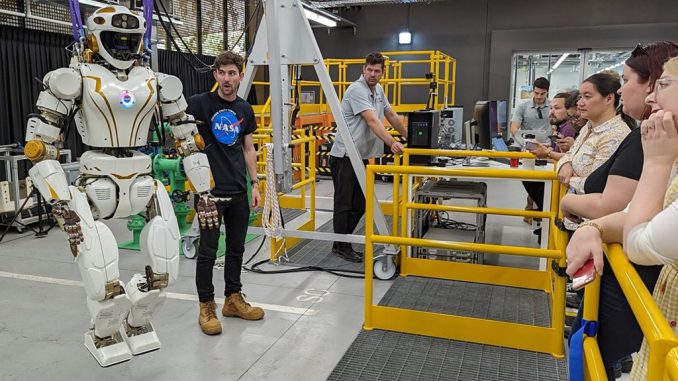
By Dean Murray
NASA’s humanoid robot has its first job – as an oil rig worker.
The Valkyrie bot is being dispatched to Australia to be deployed by an energy company to test its ability to handle “dirty and hazardous conditions.”
The space agency explains that, as part of a reimbursable Space Act Agreement with Woodside Energy in Perth, they plan to use a Valkyrie robot to develop “remote mobile dexterous manipulation capabilities” to accommodate remote caretaking of uncrewed and offshore energy facilities.
Woodside Energy will test the resulting software and provide data and feedback to NASA, helping accelerate the maturation of robotic technology.
Under this second reimbursable collaboration with Woodside, Valkyrie will advance robotic remote operations capabilities which have potential to improve the efficiency of Woodside’s offshore and remote operations while also increasing safety for both its personnel and the environment.
In addition, the new capabilities may have applications for NASA’s Artemis missions and for other Earth-based robotics objectives.
NASA plans to leverage experience operating Valkyrie in Woodside’s facilities to learn how to better design robots for work in dirty and hazardous conditions, like those found on the Moon at the long-term worksites and habitats that will be established as part of future Artemis missions.
Remotely operated mobile robots on the lunar and Martian surface could enable Earth-based operators to conduct important activities, even when astronauts are not physically present.
These activities include inspection and maintenance of infrastructure and plants that leverage resources and materials to produce new items, enabling astronauts to live off the land.

Woodside’s testing will also provide valuable data for NASA engineers on the use of advanced robots in similar terrestrial applications.
“We are pleased to be starting the next phase of development and testing of advanced robotic systems that have the potential to positively impact life on Earth by allowing safer operations in hazardous environments,” says Shaun Azimi, lead of the dexterous robotics team at NASA Johnson. “These demonstrations will evaluate the current potential of advanced robots to extend the reach of humans and help humanity explore and work safely anywhere.”
To deliver the robot, the NASA dexterous robotics team from Johnson travelled to the Woodside headquarters in Perth, Western Australia.
The team prepared the Valkyrie robot and conducted training with the Woodside team on its operations. The work culminated in a visit with representatives from the government of Western Australia and the U.S. Consul General in Perth.
Valkyrie and other advanced mobile robots can be vital tools in allowing humans to supervise dangerous work remotely and to offload dull and repetitive tasks, enabling humans to work on higher level tasks, including deploying and maintaining robots.
“These principles apply to both space and Earth, where companies are recognising the value of human-scale robots,” say NASA.
Produced in association with SWNS Talker
Edited by Saba Fatima and Asad Ali
